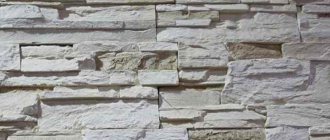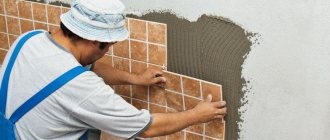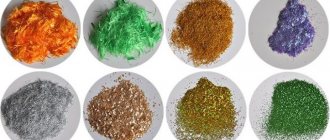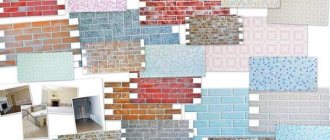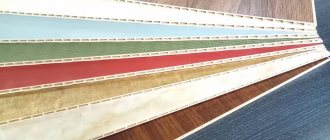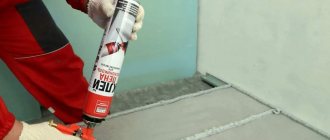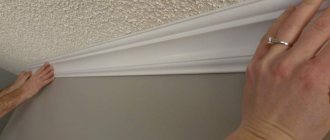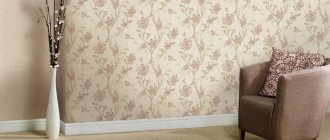When renovating an apartment, everyone tries to preserve as much usable space as possible. This can be achieved using liquid nails (LN). This is a type of construction adhesive. It is used for gluing and fastening many building materials. It is convenient to use liquid nails for plastic panels. The composition does not damage fragile plastic. The glue provides a strong adhesion that is as close as possible to a mechanical connection.
Panel adhesive requirements
Liquid nails for plastic must meet the following requirements:
- Designed specifically for PVC. The packaging says “universal” or “for plastic”.
- Provides a strong and safe connection to organic and mineral substrates. It can be stone, brick, plaster, chipboard, wood.
- Has a high degree of adhesion.
- Insensitive to moisture, detergents, temperature changes, ultraviolet radiation and chemicals.
- A common requirement for liquid nails for PVC panels is transparency.
- Service life is at least 15–20 years.
- Multifunctionality and wide scope of application: possibility of use on various planes: walls, floors, door and window slopes, interior decoration.
- Flexible and elastic.
- Convenient and economical packaging.
- Affordable price.
- Ability to glue loose parts.
- Does not corrode.
Pasting the ceiling
Ceiling panels are an excellent solution for finishing, for example, a bathroom. A wide selection of colors and textures allows you to choose PVC for any interior. The following instructions will help you figure out how to glue panels to the ceiling:
Installation of the panel on the ceiling
- It is necessary to remove any remaining whitewash from the ceiling and wipe thoroughly with a damp cloth;
- repair cracks and irregularities with putty;
- Before gluing PVC panels, the ceiling must be treated with a primer. This will provide a more reliable grip;
- Next, a thin layer of glue is applied to the degreased surface of the tile;
- ceiling panels are applied to the ceiling and held for several minutes;
- Remains of glue or liquid nails are immediately removed with a damp cloth or solvent.
Selection of adhesive composition
When renovating premises and finishing buildings, it is often necessary to glue various surfaces together. Polyvinyl chloride (PVC), wood, glass, metal, porcelain. It is very practical to glue plastic panels with liquid nails.
Liquid nails come into contact with almost any surface. The secret of such versatility lies in their special composition: they are made from artificial rubber and supplemented with fillers and polymers.
Liquid nails can be universal or used for fastening specific materials:
- for foam panels, for interior work;
- glue for mirrors that does not damage the amalgam;
- heavy-duty adhesive for heavy building materials;
- waterproof for baths;
- landscape for installation of products outside the premises;
- for MDF and wooden panels;
- for floors and decking;
- roofing sealant.
Before gluing plastic panels with liquid nails, you must read the instructions for use in detail. It indicates the materials to which this adhesive is suitable.
Look at the cap. If it is white, then the glue will be white. If the cap is transparent, the composition will be transparent. Colorless silicone-based nails are designed for plumbing work. Used for ceramics, acrylic, faience, stone, glass. It is not worth gluing wooden panels with them.
Liquid nails are acrylic (water-based) or polyurethane (neopropylene) with the addition of organic solvents.
- Acrylic. Area of application: indoors.
- Eco-friendly, safe. Without harmful toxic substances. They have no smell. They do not tolerate water and temperature changes well (it is better not to use it in the bathroom).
- Polyurethane. Instant and excellent grip. They do not respond to humidity and temperature changes. With a pungent chemical odor (disappears after two to three days). Dangerous for humans.
When working with solvent-based liquid nails, be sure to use protective gloves, goggles, and a respirator! Ensure a continuous supply of fresh air, active ventilation, and exhaust ventilation.
Types of glue
There are several types of glue, the actions of each of them are aimed at ensuring that wall panels for interior decoration fit as tightly as possible to the walls. From the list below you can familiarize yourself with the types of this glue.
Compounds for MDF stickers
This type of glue has a significant advantage - versatility. This glue can be applied to stone, metal, wooden products and others . This glue contains the following substances: Titanium, Moment and others.
Titanium
A special series containing liquid nails
Experts have developed a special series of glue that is ideal for construction work and gluing MDF even on a concrete wall. The glue can be used not only by professionals, but also by amateurs. In addition, experts have invented an addition to glue: a construction gun, which is very convenient to use and greatly simplifies working with glue.
Construction pistol
The composition includes the following substances: Installation, Liquid Nails, Macroflex and others.
Liquid Nails
The presented components are distinguished by super-strong fixation and durability. Beginning builders are recommended to use glue from the “Liquid Nails” series in their work. They are perfect for mounting your panels.
This material has a fairly wide range of advantages. The adhesion of the two products is high-quality and durable.
Using glue is very easy and does not require special skills; the glue is used very sparingly during work, due to which it can be applied in thin layers and eliminate any defects.
Construction foam to glue MDF
In general, the main purpose of this glue is to seal, however, it is often used for installing panels. Today, all manufacturers produce the presented adhesive with two compositions: one type is suitable for all construction work, and the other only for interior work.
The main components of the floor screed mortar are cement and sand. Here is the consumption of cps per 1 m2 of screed.
Decorative plaster is used for interior decoration. Here are various types of decorative plaster for interior decoration.
Today on the market you can find a wide variety of high-quality building materials. By clicking on the link, you will get acquainted with the technical characteristics of the Ceresit st 17 primer.
Actually, both may be suitable for gluing panels to the wall. After the glue dries completely, it becomes quite flexible and soft in structure, thereby eliminating the risk of deformation and damage to the surface.
Construction foam
In particular, this factor affects wood and tile products, since the properties of such materials change depending on temperature and weather conditions.
The best liquid nails for plastic
“Moment” universal – the best combination of price and quality. Manufactured in Russia. Purpose – connection of glass, concrete, brick, PVC panels, wood. The setting period is 15–30 minutes. They have significant strength. Withstands a load of 40 kg/m2. Resistant to different temperatures (from -30 to +60 degrees C). Economical consumption, convenient container, waterproof, used on uneven surfaces. They have a strong chemical smell and are toxic.
QUELYD Mastifix Ultra – the best quality. Produced in France. Construction adhesive from Quelyd is intended for installation of PVC, stone, wood and other materials. Made on acrylic. Without smell. Safe for the environment and humans. Load up to 150 kg/m2. Withstands temperatures up to +120 degrees C. Area of application – interior and exterior work. Dries quickly and works with PVC panels.
KRAFTOOL KN-95 – better grip. Produced in Germany. Liquid nails KRAFTOOL KN-915 are designed for fastening products made of polyvinyl chloride. Ideal for finishing showers and bathrooms. Connects almost any surface (plastic, wood, plaster, metal). Touch-to-touch hardening time is ten minutes. Plastic and not dangerous. Contains an antiseptic. They tolerate temperature differences and humidity well.
When choosing an adhesive, pay attention to:
- planned loads on the structure;
- compliance of the coating and type of glue;
- temperature Range.
Fastening PVC panels
Let's consider possible options for fastening to nails in liquid form:
- The frame method is the best option for finishing walls with an uneven surface. With this method, it is not necessary to prepare and level the wall; a metal profile or, in rare cases, a wooden base is screwed onto the base. The PVC themselves are attached to these structures using screws or nails. It is worth noting that this method will help level the surface, avoid mounting wiring into the wall itself; it can be laid under the structure. But there are also disadvantages. These include such indicators as significant financial costs; the design itself will reduce the area of the room, which must be taken into account when choosing this method.
- Glue method - this option requires high-quality preparation of the base before finishing. First of all, the walls are leveled, after which Liquid Nails glue is applied to the PVC from the inside and attached to the surface by pressing and holding the PVC for a couple of seconds for high-quality fixation. The adhesive method is suitable for small-sized rooms, since it does not eat up a significant part of the squares of the room, while the panels remain smooth without damage from screws or nails, but at the same time the same reliable fixation.
How to properly and efficiently glue panels to the wall
The plane where the plastic panels will be installed must be smooth, dry, and clean. Remove all tiles, wallpaper, plaster, paint. Fill cracks, holes, and chips with putty. Priming will protect against mold, moisture, and fungi. Will increase the adhesion of LG to panels. Degrease the inner surface of the PVC.
Begin installation 6–12 hours after priming. Before gluing MDF, it is necessary to conduct a test. Glue a small piece of paneling onto the wall and wait 2 days. If after a period of time no chemical interaction occurs and the material does not swell, begin installation.
Prepare the necessary tools and materials. MDF panels, suitable LG, construction gun, rag, water, sealant. For polyurethane, prepare a solvent. Sheathing without packaging must be kept indoors for at least 30 minutes.
The composition is applied to the work surface or panel. There are two application options: dotted or zigzag. The distance between applications is 30 centimeters, no more. The heavier the building material, the shorter the distance.
Press the panel down firmly. Use a rubber roller or rubber mallet. In the first 3 minutes, the position of the panel can be straightened (use a building level or plumb line). Setting occurs after 15–20 minutes, after which it will no longer be possible to move the panel.
Some features of using glue
To achieve the maximum level of fastening, it is necessary to prematurely treat the surface on which the glue will be applied; it must be dry and smooth.
Regardless of the chosen glue, it must be applied to the product in dots in fairly large drops, then wait a certain amount of time (this information is always indicated on the glue packaging), after which the panel can be applied to the wall.
Be sure to tap and press the stump well against the wall covering to secure the hold. Remaining glue can be removed immediately; for this you can use a cloth or regular alcohol; if the glue has already hardened, then remove the glue with a knife.
As mentioned above, to glue the panel to the wall covering, you can also use polyurethane foam, which is no less effective. But the application process is a little more complicated than with glue.
To treat the base of the surface, you can use a spray bottle.
Spray
Then apply a small amount of foam to the surface of the product, then attach the panel, press well, tear off and attach again. Finally , be sure to tap the material and let the glue dry completely.
That absolutely any glue intended for construction work is dangerous to human health, so you should use it very carefully and carefully, and also do not forget about safety precautions.
Regularly ventilate the room where repairs are taking place; it is also recommended to install ventilation in the room.
If you begin to notice some symptoms of poisoning, you must immediately stop working with the glue and then wait for medical help. Symptoms of poisoning may be the following: headache, nausea, blurred vision, cough and others.
If glue gets on human skin, irritation may occur. In this case, be sure to thoroughly rinse the damaged area under running water.
What mistakes should be avoided in installing MDF panels? There are some common mistakes in construction that can be made not only by beginners, but also by experienced craftsmen.
Typical errors for Liquid Nails:
- Do not overexpose the applied glue to the surface before starting work. In this case, the adhesion of the two materials will be much worse;
- If the master does not follow the rules for applying glue, then the work will turn out to be of poor quality. In addition, if even a small amount of glue ends up on the panel, the front side will lose its entire appearance;
- If you wipe off the remaining glue too thoroughly or with an overly wet cloth, the coating may begin to peel off.
Typical errors for polyurethane foam:
- In order for the work to be of high quality and the adhesion of the two surfaces to be strong, it is necessary to use only professional construction tools;
- special guns designed for polyurethane foam can regulate the amount of this material during application, so it is recommended to use this particular tool in your work so as not to make mistakes in dosages;
- If the master does not allow enough time for the foam to dry, then the material will not be fixed in subsequent coatings.
Recommendations for installing PVC panels with glue
- Make markings on the outside of the sheathing to obtain an accurate cutting line.
- Number the parts.
- Determine the starting point for installation from the door or from the corner of the room.
- If the walls are uneven, make a special sheathing from wood beams or metal profiles. It is possible to attach PVC to the sheathing on the LG. They must be applied to the sheathing itself. The distance between glue points is no more than 10 centimeters.
- The joints and seams at the junction are sealed with silicone sealant.
- If there are unsightly joints, defects and gaps, you can seal them with a decorative plastic profile.
- Exposed liquid gases must be removed immediately with a damp sponge or solvent. The hardened assembly adhesive is cut off with a sharp knife.
Basic installation errors
Despite the simplicity and convenience of installing plastic panels, some installation errors can make the finish short-lived and unattractive:
- bending finishing elements;
- removing the protective film before installation;
- cutting panels with the wrong tool or cutting from the wrong side;
- use of organic solvents or aggressive chemicals for care.
PVC panels are a practical and convenient finishing material, but non-compliance with installation technology becomes the main reason for obtaining a result that differs significantly from the desired one.
